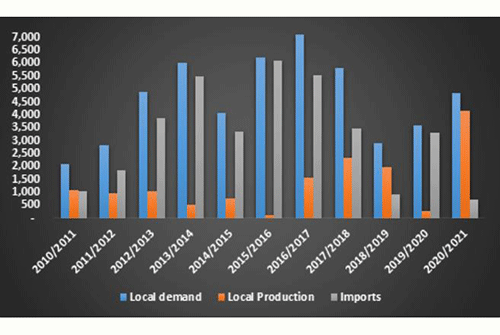Mahangu, also known as pearl millet, is one of the most common staple food crops in Namibia contributing largely to overall domestic food security.
About 95% of mahangu is locally produced while some 5% is imported from India.
For the 2020/2021 season, Namibia recorded a significantly higher production of mahangu compared to previous years on the back of good rains at the beginning of 2021.
“The period between 2010/2011 and 2020/2021 saw local mahangu production at 14 796 tons which translates into 1 345 tons per year,” stated research entity, High Economic Intelligence, in its recently released report.
Mahangu is currently the least imported grain in the country due to the fact that it is highly adaptable to low rainfall and the prevailing Namibian soil conditions.
The mahangu production for commercial purposes is concentrated mainly in the Zambezi, Kavango and Otjozondjupa regions. Producers in the Oshikoto, Oshana, Ohangwena, and Omusati regions produce mahangu primarily at a subsistence level for household consumption and only market when there is excess supply.
HEI added that the outlook on the local production of mahangu is positive due to the above-average rainfall reported for the current harvesting season. The research entity added that there is definitely room for building the necessary efficiencies in order to export this local grain.
HEI noted that the marketing of mahangu for Namibia commences on the onset of the first quarter annually and runs until it is secured by the National Strategic Food Reserve and producers.
The production of mahangu has been driven by demand over the years with a gradual increase in local production. The Zambezi region accounts for 31% of the national total tonnage of mahangu produced, followed by the Oshikoto region with 24% and the Otjozondjupa region accounts for the lowest production of mahangu at 1%.
HEI stated that the relatively low production of mahangu in the past 10 years can be attributed to a number of factors, which include supply constraints such as lack of farming equipment, machinery, and financial resources.
“In order for Namibia to scale the current production level and have a comparative advantage for the export market, there is a need for investment in research and development, training and acquiring knowledge in the use of new farming techniques,” it recommended.
mndjavera@nepc.com.na


